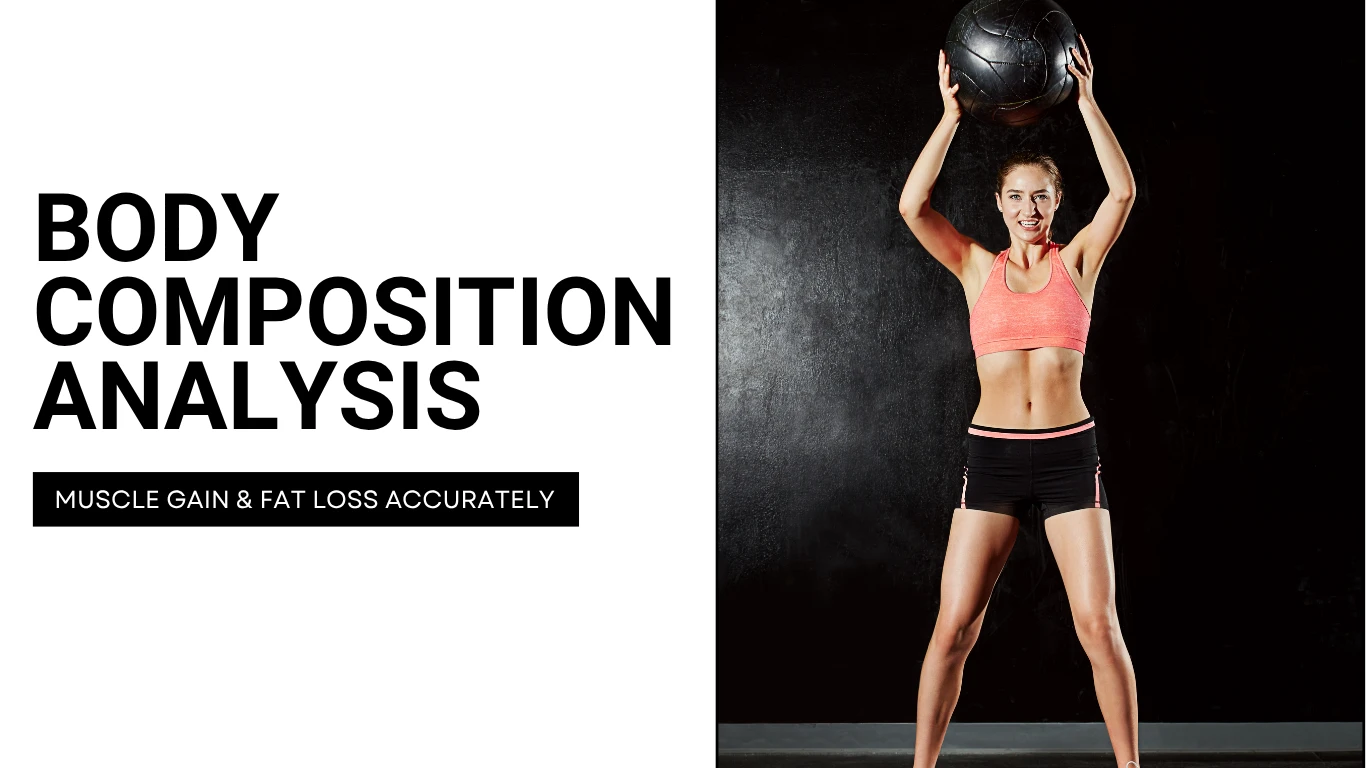Summary
Body composition analysis is a vital tool for Sports performance training and tracking fitness progress, focusing on fat, muscle, bone, and other tissues rather than just weight. It helps track muscle gain and fat loss, offering more accurate insights into physical health. Key components include fat mass, lean mass (muscle, bone), and bone density. Methods for measuring body composition include DEXA scans, bioelectrical impedance analysis (BIA), and skinfold calipers. Body fat percentage is crucial for tracking fat loss and muscle gain. Nutrition and exercise, especially strength training and cardio, play significant roles in shaping body composition. Consistent tracking, every 2-4 weeks, ensures meaningful progress. Avoid common mistakes like inconsistent measurement times or focusing only on weight. By focusing on body composition, individuals can optimize their fitness strategies, achieve personal goals, and maintain long-term health.
Introduction
Body composition analysis is a crucial tool for tracking fitness progress. Unlike simple weight measurements, it focuses on the proportion of fat, muscle, bone, and other tissues in your body. By understanding body composition, you can see how your muscle mass and fat levels change over time, offering a clearer picture of your health and fitness. This approach is especially important for setting personalized fitness goals, whether it’s gaining muscle, losing fat, or improving overall health. Various methods, such as DEXA scans, bioelectrical impedance analysis (BIA), and skinfold measurements, help track these changes accurately. In this article, we’ll explore the importance of body composition, the different measurement methods, and how to optimize your exercise and nutrition plans for better results.
Key to Fitness Progress
What is Body Composition?
Body composition refers to the proportion of fat, muscle, bone, and other tissues in the body. Unlike simple weight measurements, it provides a detailed view of physical health and fitness, focusing on the quality and distribution of these components rather than the overall weight.
Why Body Composition Matters
Tracking Progress Beyond Weight
Body composition analysis helps track muscle gain and fat loss, offering a clearer picture of physical improvement. Changes in body composition reflect true fitness progress, even when weight remains constant.
Better Health Insights
Understanding body composition can highlight health risks associated with excess body fat or low muscle mass. This provides valuable information for creating targeted fitness or nutrition plans.
Personalized Goals
Knowing your body composition enables tailored fitness strategies. For example, someone aiming for muscle gain can focus on strength training, while fat loss goals may require a combination of cardio and dietary adjustments.
Components of Body Composition
Fat Mass
Includes essential fat needed for body functions and Sports performance training stored fat. Reducing excess fat mass is often a priority for improving overall fitness.
Lean Mass
Comprises muscle, bone, and organs. Increasing lean mass supports metabolism, strength, and physical performance.
Bone Density
A vital aspect of body composition, bone density ensures structural health and reduces the risk of injuries.
Methods for Measuring Body Composition
- Bioelectrical Impedance Analysis (BIA): Uses electrical currents to estimate fat and lean mass.
- Dual-Energy X-Ray Absorptiometry (DEXA): Offers precise analysis of fat, muscle, and bone composition.
- Skinfold Measurements: Evaluates fat levels using calipers at specific body sites.
Body composition analysis is an essential tool for understanding fitness beyond weight. Focusing on muscle gain and fat loss ensures meaningful progress, improved health, and better alignment with fitness goals. Incorporating regular assessments helps stay on track for long-term success.
Body Fat Percentage: A Key Metric for Fitness Goals
What is Body Fat Percentage?
Body fat percentage is the proportion of fat in your body relative to total weight. Unlike weight alone, it provides a detailed view of physical health by distinguishing fat from lean mass, such as muscle, bone, and organs. It is a more accurate measure for tracking fitness progress, especially for fat loss and muscle gain.
Why Body Fat Percentage Matters
Accurate Fat Loss Tracking
Weight alone can fluctuate due to water retention or muscle gain, making it unreliable for assessing fat loss. Body fat percentage directly measures fat reduction, offering clear insights into progress.
Muscle vs. Fat
Understanding the balance between muscle and fat is crucial for fitness goals. An increase in lean muscle mass alongside a reduction in body fat percentage reflects improved physical health and performance.
Health Implications
High body fat percentage is linked to increased risks of chronic conditions like heart disease and diabetes. Tracking and managing this metric promotes better long-term health outcomes.
Methods to Measure Body Fat Percentage
Bioelectrical Impedance Analysis (BIA)
This method uses electrical currents to estimate fat and lean mass. It is quick and non-invasive, ideal for regular tracking.
Dual-Energy X-Ray Absorptiometry (DEXA)
DEXA scans provide highly accurate measurements, distinguishing fat mass from muscle and bone density.
Skinfold Measurements
Using calipers to measure fat thickness at specific sites offers a simple, cost-effective way to estimate body fat percentage.
Optimizing Fitness Goals with Body Fat Percentage
Monitor changes in body fat percentage rather than weight Sports performance training to stay focused on fat loss or muscle-building goals. Pair tracking with structured workouts and balanced nutrition for effective results. Regular assessments help adjust routines, ensuring steady progress.
Body fat percentage is a critical metric for fitness tracking. By prioritizing this measure over weight, individuals gain a more accurate and meaningful understanding of their physical health and progress. This focus ensures long-term success in achieving fitness goals.
Methods of Body Composition Analysis: Tools for Accuracy
DEXA Scan
Overview
Dual-Energy X-Ray Absorptiometry (DEXA) is one of the most accurate methods for body composition analysis. It uses X-rays to differentiate between fat, muscle, and bone mass.
Benefits
DEXA provides precise measurements and detailed information, making it ideal for tracking progress and health risks related to fat and bone density.
Limitations
The scan is expensive and typically requires access to specialized medical facilities.
Bioelectrical Impedance Analysis (BIA)
Overview
BIA measures body composition by sending a small electrical current through the body. The resistance encountered helps estimate fat mass and lean mass.
Benefits
BIA devices are widely available, ranging from handheld devices to scales, offering a convenient and non-invasive option.
Limitations
Accuracy can be affected by hydration levels, meal timing, and device quality.
Skinfold Calipers
Overview
Skinfold calipers measure subcutaneous fat thickness at specific sites, providing an estimate of total body fat percentage.
Benefits
Calipers are cost-effective and portable, making them accessible for routine tracking.
Limitations
Accuracy depends heavily on the skill and consistency of the person performing the measurements.
Additional Methods
Hydrostatic Weighing
This method involves submerging the body in water to calculate density and fat percentage. It is accurate but less accessible due to equipment requirements.
Air Displacement Plethysmography
Using specialized chambers, this technique measures body composition through air displacement. It offers high accuracy but comes with significant costs.
Selecting the right method depends on individual needs and resources. DEXA and hydrostatic weighing provide the most accuracy, while BIA and skinfold calipers offer convenient alternatives for regular tracking. Understanding these tools ensures informed decisions for effective fitness progress.
Muscle Gain Tracking: Tools and Progress Indicators
The Role of Body Composition Analysis in Muscle Growth
Body composition analysis helps measure changes in lean mass, offering a precise way to monitor muscle development. By separating muscle, fat, and bone mass, these tools provide a clearer picture of physical Sports performance training progress than weight alone.
Tools for Tracking Muscle Gain
Dual-Energy X-Ray Absorptiometry (DEXA)
DEXA scans offer highly accurate measurements of lean mass. They distinguish muscle from fat and bone density, making them ideal for tracking detailed changes over time.
Bioelectrical Impedance Analysis (BIA)
BIA devices measure body composition using electrical currents. They estimate lean mass and fat mass, providing convenient and non-invasive tracking options for regular use.
Skinfold Calipers
Skinfold measurements estimate body fat percentage, indirectly highlighting changes in lean muscle as fat decreases. While cost-effective, accuracy depends on consistent measurement technique.
Smart Scales
Advanced scales measure muscle and fat percentages using bioelectrical impedance. These provide quick insights into muscle gain for day-to-day tracking.
Indicators of Muscle Growth
Increased Lean Mass
Body composition tools can show an increase in lean muscle mass over time, reflecting effective strength training and recovery.
Improved Performance Metrics
Enhanced strength or endurance during workouts indicates muscle adaptation and growth. Tracking weights lifted or repetitions performed offers complementary insights.
Visible Changes
Greater muscle definition and reduced fat are visual indicators of progress, often aligning with measured increases in lean mass.
Best Practices for Monitoring Muscle Gain
- Schedule body composition measurements monthly or quarterly to track meaningful changes.
- Pair analysis with consistent workout tracking to correlate muscle growth with strength and endurance improvements.
- Focus on gradual progress rather than immediate results for sustainable development.
Body composition analysis provides valuable insights for monitoring muscle growth and lean mass. By leveraging these tools and tracking performance indicators, individuals can refine their fitness routines and achieve long-term goals effectively.
Nutrition for Body Composition: Building Muscle and Losing Fat
The Importance of Nutrition in Body Composition
Nutrition plays a pivotal role in optimizing body composition by influencing muscle gain and fat loss. A well-structured diet tailored to specific goals provides the energy and nutrients required for effective training and recovery.
Macronutrients for Muscle Building
Protein: The Foundation of Muscle Growth
Protein supports muscle repair and growth by Sports performance training providing essential amino acids. Sources like lean meats, fish, eggs, and plant-based options (tofu, lentils) should be a staple in a muscle-building diet. Aim for 1.6-2.2 grams of protein per kilogram of body weight daily.
Carbohydrates: Fuel for Performance
Carbohydrates replenish glycogen stores, fueling intense workouts and recovery. Whole grains, fruits, and vegetables are excellent choices for sustaining energy levels during training sessions.
Healthy Fats: Hormonal Support
Fats play a crucial role in hormone production, including testosterone, which supports muscle growth. Incorporate sources like avocados, nuts, seeds, and olive oil to maintain a balanced intake.
Nutrition for Fat Loss
Caloric Deficit
Achieving fat loss requires creating a caloric deficit, where energy expenditure exceeds calorie intake. This can be done by reducing portion sizes or increasing physical activity.
High-Protein Diet
A high-protein intake preserves lean muscle mass during fat loss. Protein-rich meals also promote satiety, helping control hunger.
Balanced Macronutrient Ratios
While reducing calories, maintain a balance of macronutrients to support metabolism and prevent muscle loss. Include a moderate amount of carbohydrates and healthy fats for energy and hormonal balance.
Meal Timing and Hydration
Pre- and Post-Workout Meals
Consume carbohydrates and protein before and after workouts to optimize performance and recovery. Pre-workout meals provide energy, while post-workout nutrition repairs muscles and restores glycogen.
Hydration
Proper hydration enhances nutrient transport and supports overall metabolism. Drink water consistently throughout the day and during Sports performance training.
Tailoring your diet to your fitness goals ensures steady progress in muscle building or fat loss. A balanced approach with nutrient-dense foods promotes sustainable results and improved body composition.
Body Composition Tracking Mistakes: Avoiding Fitness Progress Errors
Common Errors in Body Composition Tracking
Inconsistent Measurement Timing
Taking measurements at different times of the day can lead to fluctuations due to hydration, meals, or physical activity. This inconsistency skews results and makes progress harder to evaluate.
Using Inaccurate Tools
Relying on devices with low precision, such as outdated scales or improperly calibrated equipment, may provide misleading data. This makes it difficult to track true changes in body composition.
Ignoring Lean Mass and Fat Balance
Focusing solely on body weight without considering fat and lean muscle percentages overlooks meaningful changes. Weight alone does not reflect progress in muscle gain or fat loss.
Measuring Too Frequently
Tracking composition changes daily may lead to frustration due to natural Sports performance training fluctuations. Muscle gain or fat loss takes time and is best assessed over weeks or months.
Neglecting Other Progress Indicators
Relying only on body composition tools without tracking performance, strength, or endurance improvements can give an incomplete picture of fitness progress.
Tips to Avoid Common Mistakes
Measure Consistently
Schedule measurements at the same time and conditions, such as in the morning before meals. This reduces variability and ensures accurate tracking.
Invest in Reliable Tools
Use accurate methods like bioelectrical impedance devices, DEXA scans, or calibrated scales. Choose tools that align with your goals and provide consistent results.
Monitor Both Fat and Lean Mass
Track changes in fat and muscle percentages rather than focusing solely on weight. This approach highlights meaningful progress in body composition.
Space Out Assessments
Conduct measurements every two to four weeks to allow noticeable progress. This timeframe reduces frustration and highlights long-term improvements.
Track Additional Metrics
Incorporate performance-based indicators, such as strength increases or workout endurance, alongside body composition data. This provides a holistic view of fitness success.
Avoiding common mistakes in body composition tracking ensures accurate assessments and steady progress toward fitness goals. By following these tips, you can achieve meaningful results and stay motivated.
Exercise for Body Composition: Cardio vs. Strength Training
The Role of Exercise in Body Composition
Exercise plays a critical role in shaping body composition by influencing muscle mass and fat percentage. Choosing the right balance of cardio and strength training is essential for optimizing workouts and achieving specific fitness goals.
Cardio for Fat Loss
How Cardio Affects Fat Percentage
Cardiovascular exercises, such as running, cycling, or swimming, are effective for burning calories and reducing fat mass. Cardio primarily utilizes the aerobic energy system, helping the body burn stored fat for energy during sustained efforts.
Benefits for Body Composition
Regular cardio improves overall fat-to-muscle ratio by decreasing fat percentage. It also boosts cardiovascular health, enhancing endurance and metabolism.
Strength Training for Muscle Growth
How Strength Training Affects Muscle Mass
Strength training exercises, such as weightlifting, squats, or push-ups, stimulate muscle growth through resistance and progressive Sports performance training overload. This form of training increases lean muscle mass and strengthens connective tissues.
Benefits for Body Composition
Building muscle through strength training elevates resting metabolic rate, enabling the body to burn more calories even at rest. It helps achieve a toned physique while preserving or increasing lean mass during fat loss.
Combining Cardio and Strength Training
Optimizing Body Composition
The combination of cardio and strength training creates a balanced approach to improving body composition. Cardio helps reduce fat percentage, while strength training builds and maintains muscle mass.
Recommended Routine
Incorporate 2-3 strength training sessions per week to focus on muscle growth. Add 2-3 cardio sessions, ranging from steady-state to interval training, for effective fat loss. Adjust the intensity based on individual fitness goals.
Body Composition Progress: How Often to Track
Importance of Monitoring Body Composition
Tracking body composition progress helps assess changes in fat percentage and lean mass, providing a clear picture of fitness improvements. However, measuring too frequently can lead to frustration and overanalyzing, while infrequent tracking might miss key milestones.
Recommended Tracking Frequency
Monthly Assessments
A monthly schedule is ideal for observing meaningful changes in body composition. This interval allows time for fat loss or muscle gain to occur, offering reliable data without excessive fluctuations.
Biweekly Measurements
For those following structured fitness or nutrition programs, biweekly tracking can provide feedback on short-term progress while still avoiding unnecessary stress over daily changes.
Quarterly Evaluations
Individuals focusing on long-term goals may benefit from quarterly assessments. This approach aligns with gradual improvements and provides insights into sustainable progress.
Factors Influencing Frequency
Fitness Goals
For fat loss or muscle-building goals, more frequent tracking (every two to four weeks) helps adjust strategies effectively. Maintenance goals require less frequent monitoring.
Method Used
Accurate methods like DEXA scans or hydrostatic weighing are best utilized less often (quarterly) due to their cost and logistics, while bioelectrical impedance devices or smart scales can support more regular tracking.
Training Intensity
Athletes or individuals with high-intensity routines may opt for monthly tracking to ensure their efforts align with their goals and recovery needs.
Tips for Effective Monitoring
- Measure under consistent conditions, such as in the morning before meals, to minimize variability.
- Combine body composition data with other indicators like strength, endurance, or visual progress for a comprehensive view.
- Avoid daily measurements to reduce focus on natural fluctuations and ensure a sustainable approach to progress tracking.
By selecting a tracking frequency that suits individual goals and resources, you can monitor body composition effectively and make informed adjustments to your fitness plan. This ensures steady progress and long-term success.
Conclusion
Body composition analysis offers a Sports performance training more accurate way to track fitness progress than just focusing on weight. By measuring the proportion of fat, muscle, and other tissues, it provides a clearer picture of health and performance. Regularly monitoring body fat percentage and lean mass helps optimize goals like muscle gain or fat loss. Using tools like DEXA scans, BIA devices, and skinfold calipers can offer precise insights into body changes. Nutrition and exercise play crucial roles in shaping body composition, with a balanced approach of strength training and cardio being key. Consistent, realistic tracking every few weeks ensures steady progress while avoiding frustration. Overall, understanding and tracking body composition leads to better health, improved fitness, and long-term success in achieving personal goals.
FAQ’s
Body composition refers to the proportions of fat, muscle, bone, and other tissues in your body, providing a clearer picture of your physical health compared to just weight.
Body fat percentage helps track fat loss and muscle gain more accurately than weight alone, providing better insights into your fitness progress and overall health.
Common methods include Bioelectrical Impedance Analysis (BIA), DEXA scans, and skinfold measurements. Each method offers different levels of accuracy and convenience.
It’s ideal to track body composition every 2-4 weeks, allowing enough time to see meaningful changes without overanalyzing daily fluctuations.






